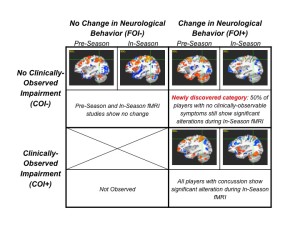Conservative estimates indicate that, in 2003, there were 1.5 million cases of traumatic brain injury (TBI) in the United States, resulting in 51,000 deaths, 290,000 hospitalizations, and over 1 million emergency room visits. The incidence of TBI is especially high in children under the age of 14, many of whom participate in contact sports such as football, hockey, and lacrosse. Today, approximately 3.2 million individuals are living with long-term disabilities as a result of TBI-related injuries. Based on recent work with our long time (over a decade!) collaborators, it has become clear that these numbers are only the tip of the iceberg. Chronic neurophysiological changes resulting from head trauma affect more than 70% of a typical high school football team. As a result, the Centers for Disease Control noted that TBI is no longer a silent epidemic, but something that has the potential to affect people of all ages and all walks of life. In order to prevent these injuries and improve treatment outcomes it is necessary to develop (1) methods for the early identification of neurophysiological changes, (2) the ability to identify which anatomical structures and cell types are injured, and (3) interventions designed to prevent or treat the injuries.
Below are some of the nearly 50 papers we have published delineating the structural, functional, and chemical changes in the brain as a result of repetitive head impacts, the biomechanics of head impacts, and the characterization of helmet efficacy.
Talavage, T.M., Nauman, E.A., Breedlove, E.L., Yoruk, U., Dye, A.E., Morigaki, K., Feuer, H., Leverenz, L.J. Functionally-detected cognitive impairment in high school football players without clinically-diagnosed concussion. Journal of Neurotrauma. Vol. 31, No. 4, p. 327-338, 2014.
Breedlove, E.L., Robinson, M., Talavage, T.M., Morigaki, K.E., Yoruk, U., O’Keefe, K., King, J., Leverenz, L.J., Gilger, J.W., Nauman, E.A. Biomechanical Correlates of Symptomatic and Asymptomatic Neurophysiological Impairment in High School Football. Journal of Biomechanics. Vol. 45, No. 7, p. 1265-1272, 2012.
Breedlove, K. M., Breedlove, E. L., Robinson, M., Poole, V. N., King, J. R. III, Rosenberger, P., Rasmussen, M., Talavage, T. M., Leverenz, L. J., and Nauman, E. A. Detecting Neurocognitive and Neurophysiological Changes as a Result of Subconcussive Blows in High School Football Athletes. Athletic Training and Sports Health Care. Vol. 6, No. 3, p. 119-127, 2014.
Poole, V.N., Abbas, K., Shenk, T.E., Breedlove, E.L., Breedlove, K.M., Robinson, M.E., Leverenz, L.J., Nauman, E.A., Talavage, T.M., and Dydak, U. MR Spectroscopic Evidence of Brain Injury in the Non-Diagnosed Collision Sport Athlete. Dev Neuropsycho. Vol. 39, No. 6, pp. 459-473, 2014.
Abbas, K. Shenk, T.E., Poole, V.N., Breedlove, E.L., Leverenz, L.J., Nauman, E.A., Talavage, T.M., and Robinson, M.E. Alteration of Default Mode Network in High School Football Athletes Due to Repetitive Subconcussive Traumatic Brain Injury: A Resting-State Functional Magnetic Resonance Imaging Study. Brain Connect. Vol. 5, No. 2, p. 91-101, 2015.
Auger, J., Markel, J., Pecoski, D.D., Leiva-Molano, N., Talavage, T.M., Leverenz, L. Shen, F., Nauman, E.A. Factors Affecting Peak Impact Force During Soccer Headers and Implications for the Mitigation of Head Injuries. PLoS One. Vol. 15, No. 10, 2020.
Diekfuss, J.A., Yuan, W., Dudley, J.A., DiCesare, C.A., Panzer, M.B., Talavage, T.M., Nauman, E., Bonnette, S., Slutsky-Ganesh, A.B., Clark, J., Anand, M., Altaye, M., Leach, J.L., Lamplot, J.D., Galloway, M., Pombo, M.W., Hammond, K.E. and Myer, G.D. Evaluation of the Effectiveness of Newer Helmet Designs with Emergent Shell and Padding Technologies versus Older Helmet Models for Preserving White Matter Following a Season of High School Football. Ann Biomed Eng. Vol. 49, No. 10, p. 2863-2874, 2021.
Vike, N.L., Bari, S., Stetsiv, K., Talavage, T.M., Nauman, E.A., Papa, L., Slobounov, S., Breiter, H.C., and Cornelis, M.C. Metabolomic response to collegiate football participation: Pre- and Post-season analysis. Sci. Rep. Vol. 12, No. 1, 2022.

